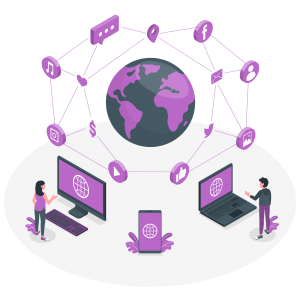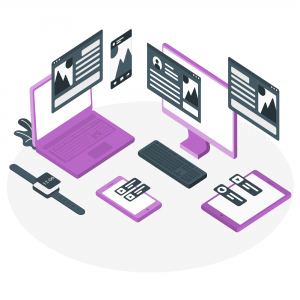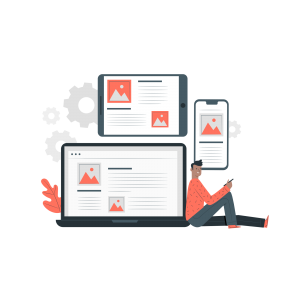Software Development
Introduction
 We can talk about software development. So, you know how when you use your favorite apps on your phone or computer, they just seem to work like magic? Well, that’s all thanks to software developers who put in a ton of effort behind the scenes to make it happen. You’ve got an idea for an app or a program that you think would be super useful or fun. That’s where software development comes into play. It’s basically the whole process of turning that idea into a real, working piece of software. First things first, you’ve got to plan it all out. What’s the app going to do? Who’s going to use it? How’s it going to look and feel? All these questions need answers before you even start writing any code. Once you’ve got a plan, it’s time to dive into the coding part. This is where the developers roll up their sleeves and start writing lines and lines of code in languages like Java, Python, or C++. It’s kind of like building a house – you start with a foundation (the code), then you add walls, windows, doors, and all the other stuff that makes it a home (or in this case, an app)
We can talk about software development. So, you know how when you use your favorite apps on your phone or computer, they just seem to work like magic? Well, that’s all thanks to software developers who put in a ton of effort behind the scenes to make it happen. You’ve got an idea for an app or a program that you think would be super useful or fun. That’s where software development comes into play. It’s basically the whole process of turning that idea into a real, working piece of software. First things first, you’ve got to plan it all out. What’s the app going to do? Who’s going to use it? How’s it going to look and feel? All these questions need answers before you even start writing any code. Once you’ve got a plan, it’s time to dive into the coding part. This is where the developers roll up their sleeves and start writing lines and lines of code in languages like Java, Python, or C++. It’s kind of like building a house – you start with a foundation (the code), then you add walls, windows, doors, and all the other stuff that makes it a home (or in this case, an app)
Analysis
 But, just like with building a house, you’ve got to make sure everything works properly. That’s where testing comes in. Developers run all kinds of tests to make sure the app does what it’s supposed to do and doesn’t do anything it’s not supposed to do (like crash or freeze up).Once the app passes all the tests and everyone’s happy with how it looks and works, it’s time to release it into the wild! People can download it from app stores or websites and start using it for themselves. But wait, there’s more! The job doesn’t end there. Software developers have to keep an eye on their apps, fixing any bugs that pop up and adding new features to keep things fresh and exciting for users. And there you have it – software development in a nutshell! It’s a fascinating process that combines creativity, problem-solving, and a whole lot of hard work to bring awesome apps and programs to life. Once the requirements have been gathered, they need to be analyzed. This involves understanding the requirements in detail and identifying any potential problems or conflicts. The analysis can be done through a variety of methods, such as use cases, data flow diagrams, and state machines.
But, just like with building a house, you’ve got to make sure everything works properly. That’s where testing comes in. Developers run all kinds of tests to make sure the app does what it’s supposed to do and doesn’t do anything it’s not supposed to do (like crash or freeze up).Once the app passes all the tests and everyone’s happy with how it looks and works, it’s time to release it into the wild! People can download it from app stores or websites and start using it for themselves. But wait, there’s more! The job doesn’t end there. Software developers have to keep an eye on their apps, fixing any bugs that pop up and adding new features to keep things fresh and exciting for users. And there you have it – software development in a nutshell! It’s a fascinating process that combines creativity, problem-solving, and a whole lot of hard work to bring awesome apps and programs to life. Once the requirements have been gathered, they need to be analyzed. This involves understanding the requirements in detail and identifying any potential problems or conflicts. The analysis can be done through a variety of methods, such as use cases, data flow diagrams, and state machines.
Design
The next step is to design the software application. This involves creating the high-level and detailed design documents. The design documents should specify the architecture, the user interface, and the data structures of the software application.

we can build your proffensional Andriod App
 Once we’ve gathered all the requirements for a project, the next step is to analyze them carefully. This is where we really dig deep into the details and try to understand every aspect of what’s needed. We look for any potential issues or conflicts that might arise and try to address them upfront. There are different methods we use for this analysis, like creating use cases, data flow diagrams, and state machines. These tools help us visualize how the system will work and identify any areas that might need further clarification or refinement. By thoroughly analyzing the requirements at this stage, we can ensure that we’re on the right track and that the final product will meet the needs of our users effectively. It is a great way to learn the basics of software or desktop development. It can help you decide if software or desktop development is right for you. It can help you build your skills and knowledge. It can help you network with other developers.Software development is the process of creating, designing, deploying, and maintaining software applications. It is a complex and challenging process that requires a variety of skills and expertise. The software development life cycle (SDLC) is a framework that helps to structure and manage the software development process. The SDLC typically includes the following phases: requirements gathering, analysis, design, development, testing, deployment, and maintenance. There are many different software development methodologies that can be used, each with its own advantages and disadvantages. Some popular software development methodologies include waterfall, agile, and spiral. The success of a software development project depends on a number of factors, including the right team, the right tools, the right methodology, good communication, and flexibility.
Once we’ve gathered all the requirements for a project, the next step is to analyze them carefully. This is where we really dig deep into the details and try to understand every aspect of what’s needed. We look for any potential issues or conflicts that might arise and try to address them upfront. There are different methods we use for this analysis, like creating use cases, data flow diagrams, and state machines. These tools help us visualize how the system will work and identify any areas that might need further clarification or refinement. By thoroughly analyzing the requirements at this stage, we can ensure that we’re on the right track and that the final product will meet the needs of our users effectively. It is a great way to learn the basics of software or desktop development. It can help you decide if software or desktop development is right for you. It can help you build your skills and knowledge. It can help you network with other developers.Software development is the process of creating, designing, deploying, and maintaining software applications. It is a complex and challenging process that requires a variety of skills and expertise. The software development life cycle (SDLC) is a framework that helps to structure and manage the software development process. The SDLC typically includes the following phases: requirements gathering, analysis, design, development, testing, deployment, and maintenance. There are many different software development methodologies that can be used, each with its own advantages and disadvantages. Some popular software development methodologies include waterfall, agile, and spiral. The success of a software development project depends on a number of factors, including the right team, the right tools, the right methodology, good communication, and flexibility.
Some of the benefits of free training include:
It is a great way to learn the basics of software or desktop development. It can help you decide if software or desktop development is right for you. It can help you build your skills and knowledge. It can help you network with other developers.
